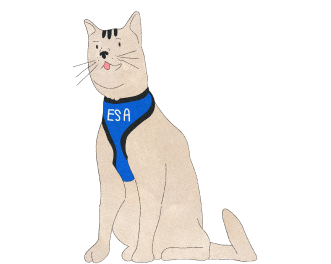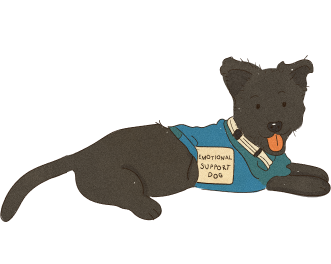For individuals with emotional support animals (ESAs), a vest can be an essential accessory that provides a range of benefits. In this article, we’ll explore the different aspects of emotional support animals and why an ESA vest can be a crucial tool for owners.
Understanding Emotional Support Animals (ESAs)
Before getting into the specifics of ESA vests, it’s essential to understand what emotional support animals are and how they can help individuals who need emotional support.
Emotional support animals have become increasingly popular in recent years as more people recognize the benefits they can provide. These animals can help individuals with a range of mental and emotional disabilities, including anxiety, depression, and post-traumatic stress disorder (PTSD).
Research has shown that emotional support animals can have a positive impact on mental health. Studies have found that spending time with animals can help reduce stress, anxiety, and depression, as well as lower blood pressure and improve overall mood.
What is an Emotional Support Animal?
An emotional support animal is a companion animal that provides emotional support to individuals with mental or emotional disabilities. These animals can be any species, including dogs, cats, rabbits, and even birds.
To qualify as an emotional support animal, the animal must be prescribed as part of a therapeutic treatment plan by a licensed healthcare professional. The healthcare professional must determine that the animal provides emotional support that alleviates one or more symptoms or effects of the individual’s disability.
The Difference Between ESAs and Service Animals
It’s important to note that ESAs and service animals are not the same. Service animals are highly trained animals that are trained to perform specific tasks to assist individuals with disabilities. These tasks can include guiding individuals who are blind, alerting individuals who are deaf, and assisting individuals who have mobility impairments.
ESAs, on the other hand, are companions that provide emotional support and do not require any specialized training. They are not trained to perform specific tasks related to a person’s disability, but rather to provide comfort and emotional support.
Legal Rights and Protections for ESAs
Emotional support animals have several legal protections under the Fair Housing Act and the Air Carrier Access Act. These protections allow individuals with ESAs to live with their animals in housing that otherwise might prohibit pets and to travel with their animals on planes, provided they have the proper documentation.
However, it’s important to note that not all animals qualify as emotional support animals. The animal must be prescribed by a licensed healthcare professional and must provide emotional support that alleviates one or more symptoms or effects of the individual’s disability. Additionally, individuals with ESAs must have documentation from their healthcare provider and must follow specific guidelines when traveling with their animals.
Overall, emotional support animals can provide invaluable support to individuals with mental and emotional disabilities. By providing emotional support and companionship, these animals can help individuals lead happier, healthier lives.
The Importance of an Emotional Support Animal Vest
For individuals who rely on emotional support animals, an ESA vest can be an extremely important accessory. Here, we’ll explore why.
Emotional support animals (ESAs) are companion animals that provide comfort and support to individuals with emotional or psychological disabilities. These animals are not the same as service animals, which are trained to perform specific tasks for individuals with disabilities. However, ESAs are protected under the Fair Housing Act and the Air Carrier Access Act, which means that individuals with ESAs have the right to live with their animals and travel with them on airplanes.
Identification and Recognition
One of the primary benefits of an ESA vest is that it helps to identify an animal as an emotional support animal. This identification can be especially important when navigating housing or travel situations.
When an individual with an ESA wears a vest that clearly identifies their animal as an ESA, landlords and airlines are more likely to recognize the animal’s status and provide the necessary accommodations. This can help individuals with ESAs avoid confrontations and ensure that their rights are respected.
It’s important to note that while an ESA vest can be helpful in identifying an animal as an ESA, it is not required by law. However, many individuals with ESAs choose to use a vest as an additional form of identification and recognition.
Reducing Misunderstandings and Confrontations
Wearing an ESA vest can also help to reduce misunderstandings and confrontations with individuals who may not understand the role of emotional support animals. Unfortunately, there is still a lot of misinformation and stigma surrounding ESAs, which can lead to confrontations and even discrimination.
An ESA vest can serve as a visual cue that an animal is more than a pet and that it has a specific role in supporting an individual’s emotional well-being. This can help to educate others about the importance of ESAs and reduce misunderstandings and confrontations.
Ensuring Public Safety
An ESA vest can also help to ensure public safety by clearly identifying an animal as a companion animal. This identification is especially important in situations where an animal may be required to be on a leash or under other specific guidelines to ensure safety.
For example, if an individual with an ESA is walking their animal in a public park, other individuals may not be aware that the animal is a companion animal. If the animal is wearing a vest that clearly identifies it as an ESA, other individuals will be more likely to understand that the animal is not a pet and may require different guidelines or accommodations.
In conclusion, an ESA vest can be an important accessory for individuals with emotional support animals. It can help to identify an animal as an ESA, reduce misunderstandings and confrontations, and ensure public safety. While it is not required by law, many individuals with ESAs choose to use a vest as an additional form of identification and recognition.
Types of Emotional Support Animal Vests
If you’re considering an ESA vest for your emotional support animal, there are a few different types to consider. In this article, we’ll explore the different types of vests available, as well as some tips for choosing the right one for your furry friend.
Material and Design Options
ESA vests can be made from a variety of materials, each with their own benefits and drawbacks. Mesh vests are lightweight and breathable, making them a good choice for warmer climates. Nylon vests are durable and water-resistant, making them a good choice for outdoor activities. Cotton vests are comfortable and soft, but may not be as durable as other materials.
Design options can also vary, with some vests including reflective materials or other safety features. Reflective materials can be especially helpful for animals who work in low-light conditions or who may be difficult to see in certain environments.
Customization and Personalization
ESA vests can also be customized and personalized to suit an individual’s preferences or needs. Some companies offer customized embroidery or lettering to help identify the animal or to display important information, such as the animal’s name or any medical conditions they may have.
Personalization can also be helpful for individuals who may have multiple emotional support animals, as it allows them to easily identify which animal is which.
Sizing and Fitting Tips
When choosing an ESA vest, it’s important to ensure that you select the appropriate size and fit for your animal. Vests that are too loose or too tight can be uncomfortable for animals and may interfere with their ability to perform their chosen tasks.
To determine the correct size for your animal, measure their girth (the widest part of their chest) and add a few inches to allow for movement. It’s also important to consider the type of animal you have, as different animals may have different fitting requirements.
Overall, choosing the right ESA vest for your animal can help make their work easier and more comfortable, while also providing important identification and safety features. By considering the different types of vests available and following these fitting tips, you can help ensure that your animal is happy, healthy, and well-protected.
How to Obtain an Emotional Support Animal Vest
If you’re interested in obtaining an ESA vest for your emotional support animal, there are a few different routes you can take. An emotional support animal vest can be a helpful tool for indicating to others that your animal is an ESA and should be treated accordingly. Here are some additional details to consider when obtaining an ESA vest.
Online Retailers and Specialty Stores
Several online retailers and specialty stores offer a range of ESA vests in different sizes, materials, and designs. When shopping online, be sure to select a reputable retailer with a history of positive customer reviews. You may also want to consider purchasing from a specialty store that caters specifically to emotional support animals, as they may have a wider range of options and more knowledgeable staff.
Required Documentation for ESA Vests
In most cases, you’ll need to provide documentation from a licensed healthcare professional that prescribes an emotional support animal as part of your treatment plan. This documentation can be used to ensure that you receive the appropriate accommodations when traveling or living in housing that otherwise may prohibit pets. It’s important to note that there are several different types of healthcare professionals who can provide this documentation, including psychologists, psychiatrists, and licensed clinical social workers.
Additionally, the documentation should include information about your specific animal, such as its breed, age, and any training it has received. This can be helpful for airlines or landlords who may have questions about your animal’s suitability as an ESA.
Tips for Choosing the Right Vest
When choosing an ESA vest, it’s important to consider your specific needs and preferences, as well as the needs and comfort of your animal. Look for vests that are made from high-quality materials and that fit your animal properly. It’s also a good idea to choose a vest that clearly indicates that your animal is an ESA, such as one that says “Emotional Support Animal” or has a patch with the ESA symbol.
Another consideration when choosing an ESA vest is the level of visibility you want for your animal. Some vests are brightly colored or have reflective strips, which can be helpful for ensuring that your animal is visible in low-light conditions. Other vests may have pockets or pouches for carrying essential items like medication or waste bags.
Ultimately, the right ESA vest for you and your animal will depend on your individual needs and preferences. By taking the time to research your options and choose a high-quality vest, you can help ensure that your emotional support animal is treated with the respect and accommodations it deserves.
Conclusion
For individuals with emotional support animals, an ESA vest can be an essential tool in ensuring the animal’s safety and well-being, as well as the owner’s legal rights and protections. With a range of materials, designs, and customization options, choosing the right ESA vest is an important step in providing the necessary support and care for you and your emotional support animal.



 Facebook
Facebook LinkedIn
LinkedIn Twitter
Twitter Copy Link
Copy Link
